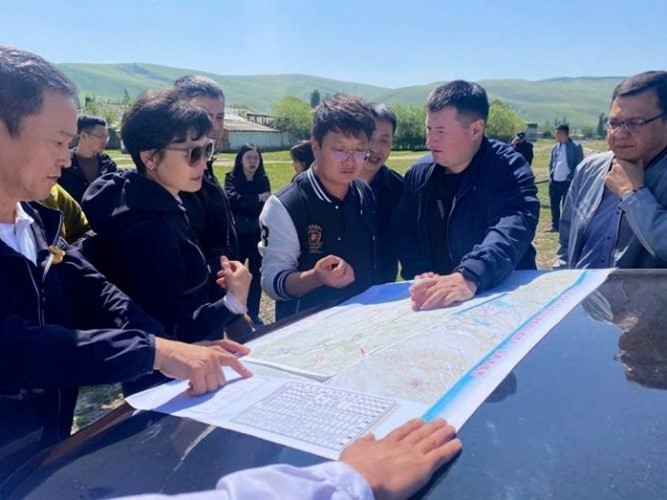The launch of the China-Kyrgyzstan-Uzbekistan railway, the construction of which will start in October 2024, will strengthen transport connectivity in Central Asia and increase the transit attractiveness of the region, believes Uzbek expert Nargiza Umarova.
Growing geopolitical tensions in the world threaten the security of traditional sea routes on the one hand, and stimulate the development of land transport corridors on the other. Such changes contribute to the effective implementation of the transit potential of Central Asia, located in the heart of the Eurasian continent.
Recognizing their significant role in establishing proper communication between global economic centers, the states in the region actively diversify their trade relations and routes. This process contributes to both strengthening transport connectivity within the region and integrating it into the system of international transit transportation. A vivid example is the construction project of the China-Kyrgyzstan-Uzbekistan (CKU) railway.
The intergovernmental agreement on the implementation of the project was signed by the parties on June 6, 2024 in Beijing. The railway will run along the Kashgar-Torugart-Makmal-Jalal-Abad-Andijan route. The total length of the route will be 486 km.
In the future, the railway line may function as an autonomous transport corridor servicing export-import cargo of the project’s beneficiary countries, or become an important component of intercontinental trade routes. These include:
Multimodal routes along the line China-Persian Gulf and China-Europe in transit through Iran. Several connecting schemes are possible here:
– connecting the CKU with the Uzbekistan-Turkmenistan-Iran railway corridor and then through Iranian ports on the coast of the Persian Gulf and the Gulf of Oman to the Middle East countries (under the Ashgabat Agreement of 2011);
– connecting the CKU with the Trans-Afghan Railway with access to Pakistani ports in the Indian Ocean;
– extending the CKU to Afghanistan and constructing the China-Kyrgyzstan-Uzbekistan-Afghanistan-Iran corridor through Iranian ports to the Gulf countries;
– connecting the CKU with the Uzbekistan-Turkmenistan-Iran-Turkey railway corridor with subsequent shipment of goods to European countries.
The China-Kyrgyzstan-Uzbekistan railway can be partially integrated into the following existing transport corridors:
- The Central Asia-South Caucasus-Anatolia multimodal route (CASCA+)
- The transport Southern corridor in the direction of Kyrgyzstan-Uzbekistan-Turkmenistan-Caspian Sea-Russia.
The launch of the China-Kyrgyzstan-Uzbekistan railway will significantly strengthen the positions of Uzbekistan and Kyrgyzstan in intercontinental freight transportation and bypass the current monopoly of Kazakhstan, which is the only Central Asian country with railway border checkpoints on the border with China. An alternative to the Middle Corridor will appear.
Transportation of cargo from Chinese Kashgar to the borders of Uzbekistan via the Kyrgyz road network takes 2 days instead of 10 days via Kazakhstan. The construction of the China-Kyrgyzstan-Uzbekistan railway will allow achieving even greater results. According to calculations, the trade route from East Asia to the Middle East and Southern Europe will be reduced by 900 kilometers, and the delivery time of goods by 7-8 days.
When the China-Kyrgyzstan-Uzbekistan railway corridor is launched, a part of the Chinese cargo flow going along the northern and central route of the Middle Corridor (Kazakhstan) to Europe is expected to be reoriented to the southern route passing through Kyrgyzstan, Uzbekistan and Turkmenistan. This will lead to an expansion of transit opportunities for the Central Asian countries and will increase competition between them. However, one must be careful not to turn business competition into rivalry, which could undermine the foundations of the emerging Central Asian unity. As a precaution, it is proposed to create a special structure in the format of a legal entity to coordinate the actions of the parties on the issue of joint development of the Trans-Caspian International Transport Route (TITR) with an emphasis on consolidating efforts in this direction.
It is noteworthy that after the signing of the agreement in Beijing on the construction of the China-Kyrgyzstan-Uzbekistan railway, some foreign media outlets immediately began to contrast this project with the Russian Trans-Siberian Railway and the Middle Corridor through Kazakhstan. In our opinion, such publications create a biased attitude towards the new railway, giving it a pronounced geopolitical coloring. After all, for Uzbekistan, the implementation of the project is of purely economic interest. This is, first of all, an opportunity to reduce transportation costs when exporting and importing goods, as well as to earn money on the development of the export of transit services.
In the current dynamics, it seems important to promote our own narrative (counter-narrative) about the potential of the CKU, which would clearly and distinctly express Uzbekistan’s position regarding the goals and objectives of the project being implemented.
The launch of the China-Kyrgyzstan-Uzbekistan railway will give impetus to the development of new international transport corridors that provide Kyrgyzstan with access to the sea. Currently, the Iran-Turkmenistan-Uzbekistan-Kyrgyzstan route is operating . The railway line extends from the port of Bandar Abbas to the city of Osh. Over the course of nine months in 2023, more than 33,000 tons of cargo were transported in this direction. The parties are considering test launching a container train between Iran and Kyrgyzstan. In the meantime, Bishkek hopes to reach the borders of Turkey via Iranian roads. For this purpose, a Kyrgyzstan-Uzbekistan-Turkmenistan-Iran-Turkey multimodal corridor is being formed.
AUTHOR’S BIO: Nargiza Umarova is a Research Fellow at the Institute for Advanced International Studies (IAIS) , University of World Economy and Diplomacy (UWED) and an analyst at the Non-governmental Research Institution “Knowledge Caravan” (Tashkent, Uzbekistan).
Her research activities are focused on studying the developments of Central Asia, trends in regional integration and the influence of big powers on this process. Also she explores the current policy of Uzbekistan on the creation and development of international transport corridors.
/// nCa, 14 August 2024 (Cross post from Cabar.Asia – originally published at https://cabar.asia/en/how-will-the-construction-of-the-china-kyrgyzstan-uzbekistan-railway-affect-the-transport-connectivity-of-central-asia-2)
